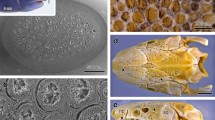Abstract
The skin structures of 4 species of oxudercine gobies (3 species ofBoleophthalmus and 1 species ofScartelaos) were investigated in relation to the terrestrial exposure of these fishes. These species have similarities in both lifestyle and skin structure. The specializations for terrestrial life mainly include the presence of dermal bulges, a thick middle cell layer, and a vascularized epidermis. Moreover, mucous cells are distributed only on the epidermis where the capillaries are undeveloped. In all species, the dermal bulges are large on the head and dorsal body, which are most often exposed to the air, and push up a thin epidermis, forming so-called papillae. Capillaries are densely distributed on the apical area of each papilla. InBoleophthalmus, the middle cell layer is thicker, the bulges are larger and distributed over a greater part of the body, and the area of the skin surface having the papillae is larger than it is inScartelaos. These differences suggest that the contribution of the skin to respiration is comparatively large inBoleophthalmus species, reflecting their more frequent activities on mudflats relative to the activities of theScartelaos species, which prefer to stay in the water. Mucous cells are abundantly distributed on the epidermis surface between the papillae in all species. The separation of the capillaries and the mucous cells may be due to an impeding of gas exchange by the mucus.
Similar content being viewed by others
Literature Cited
Al-Kadhomiy, N. K. and G. M. Hughes. 1988. Histological study of different regions of the skin and gills in the mudskipper,Boleophthalmus boddarti with respect to their respiratory function. J. Mar. Biol. Assn. U. K., 68: 413–422.
Clayton, D. A. 1993. Mudskippers, Oceanogr., Mar. Biol. Annu. Rev., 31: 507–577.
Dotsu, Y. and M. Matoba 1977 Behaviours of the mudskippersBoleophthalmus pectinirostris andPeriophthalmus modestus in Ariake Sound. Anima., 5: 15–23. (In Japanese)
Graham, J. B. 1997. Air-breathing fishes: evolution, diversity, and adaptation. Academic Press, San Diego. xi+299 pp.
Ikebe, Y. and T. Oishi. 1996. Correlation between environmental parameters and behaviour during high tides inPeriophthalmus modestus. J. Fish. Biol., 49: 139–147.
Low, W. P., Y. K. Ip and D. J. W. Lane. 1990. A comparative study of the gill morphomery in the mudskippers—Periophthalmus chrysospilos, Boleophthalmus boddaerti andPeriophthalmodon schiosseri. Zool. Sci., 7: 29–38.
MacNae, W. 1968. A general account of the fauna and flora of mangrove swamps and forests in the Indo-west pacific region. Adv. Mar. Biol., 6: 73–270
Maekawa, K., Y. Fukuda, Z. Okada and K. Imamura. 1968. Intraepithelial blood capillaries in the air-breathing organs of fish. Tokyo Med. Coll. Mag., 26: 793–799.
Mittal, A. K. and J. S. D. Munshi. 1971. A comparative study of the structure of the skin of certain air-breathing fresh-water teleosts. J. Zool., London, 163: 515–532.
Murdy, E. O. 1989. A taxonomic revision and cladistic analysis of the oxudercine gobies (Gobiidae: Oxudercinae). Rec. Australian Mus. Suppl., 11: 1–93.
Murdy, E. O. and T. Takita. 1999Periophthalmus spilotus, a new mudskipper from Sumatra (Gobiidae: Oxudercinae). Ichthyol. Res., 46: 367–370.
Niva, B., J. Ojha and J. S. D. Munshi. 1981. Morphometrics of the respiratory organs of an estuarine goby,Boleophthalmus boddaerti. Japan. J. Ichthyol., 27: 316–326.
Schöttle, E. 1931. Morphologie und Physiologie der Atmung bei wasser-, schlamm-, und landlebenden Gobiiformes. Z. Wiss. Zool., 140: 1–114.
Suzuki, N. 1992. Fine structure of the epidermis of the mudskipper,Periophthalmus modestus (Gobiidae). Japan. J. Ichthyol., 38: 379–396.
Takita, T., Agusnimar and A. B. Ali. 1999. Distribution and habitat requirements of oxudercine gobies (Gobiidae: Oxudercinae) along the Straits of Malacca. Ichthyol. Res., 46: 131–138.
Tamura, S. O., H. Morii and M. Yuzuriha. 1976. Respiration of the amphibious fishesPeriophthalmus cantonensis andBoleophthalmus chinesis in water and on land. J. Exp. Biol., 65: 97–107.
Whitear, M. 1986. The skin of fishes including cyclostomes. Pages 8–53in J. Bereiter-Hahn, A. G. Matoltsy and K. S. Richards. eds. Biology of the integument-2. vertebrate. Springer-Verlag Press, New York. xv+855 pp.
Yokoya, S. and O. S. Tamura 1992. Fine structure of the skin of the amphibious fishes.Boleophthalmus pectinirostris andPeriophthalmus cantonensis, with special reference to the location of blood vessels. J. Morphol., 214: 287–297.
Author information
Authors and Affiliations
Corresponding author
About this article
Cite this article
Zhang, J., Taniguchi, T., Takita, T. et al. On the epidermal structure ofboleophthalmus andscartelaos mudskippers with reference to their adaptation to terrestrial life. Ichthyological Research 47, 359–366 (2000). https://doi.org/10.1007/BF02674263
Received:
Revised:
Accepted:
Published:
Issue Date:
DOI: https://doi.org/10.1007/BF02674263




